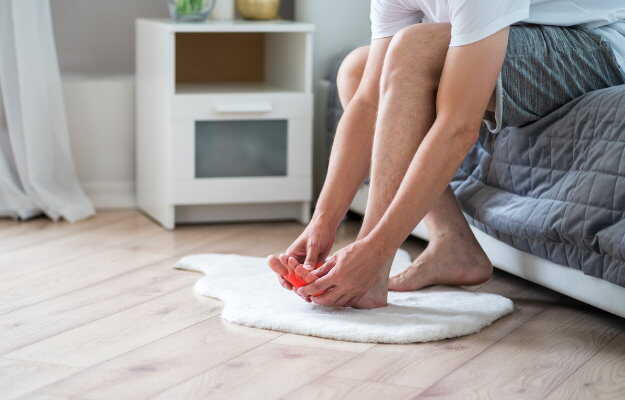Living with diabetes often entails managing various symptoms and complications, one of the most common being diabetic foot pain. Diabetic foot pain can range from mild discomfort to severe neuropathic pain, making it crucial to find effective ways to alleviate it. While medical treatment is essential, there are several home remedies and lifestyle adjustments that can complement professional care. In this blog, we’ll explore some proven home remedies to help manage diabetic foot pain effectively.
Contents
What is Diabetic Foot Pain?

Diabetic foot pain can stem from various factors, including neuropathy, poor circulation, foot deformities, and foot ulcers. Neuropathy, a common complication of diabetes, occurs due to nerve damage, leading to tingling, numbness, or burning sensations in the feet.
Poor circulation can exacerbate foot pain by impairing blood flow to the lower extremities, while foot deformities and ulcers can cause additional discomfort and complications. Managing diabetic foot pain requires a comprehensive approach that addresses both its underlying causes and associated symptoms.
Are Home Remedies for Diabetic Foot Pain Effective?
While home remedies can offer some relief for diabetic foot pain, it’s important to note that they are not a substitute for professional medical care. Diabetic foot pain can be a sign of serious complications such as nerve damage or poor circulation, which require prompt attention from a healthcare provider. However, certain home remedies may help alleviate discomfort and promote better foot health when used in conjunction with medical treatment.
Home remedies for diabetic foot pain can provide several benefits for individuals managing this condition:
- Accessible Relief: Many home remedies for diabetic foot pain utilize simple household items or techniques, making them easily accessible and convenient for individuals to use at home without the need for specialized equipment or prescriptions.
- Cost-Effective: Home remedies often involve inexpensive or readily available ingredients, which can be more cost-effective compared to medical treatments or over-the-counter medications. This can be particularly beneficial for individuals on a tight budget or those without health insurance coverage.
- Natural Approach: Home remedies often focus on natural ingredients and techniques, which may appeal to individuals who prefer a holistic or complementary approach to managing their health. Natural remedies may also have fewer side effects compared to pharmaceutical medications.
- Empowerment and Self-Care: Using home remedies for diabetic foot pain encourages individuals to take an active role in their self-care and management of their condition. By learning and implementing these remedies, individuals can feel empowered to address their symptoms and improve their overall well-being.
- Enhanced Comfort and Relaxation: Many home remedies, such as warm foot baths or gentle massages, promote relaxation and comfort, which can help alleviate stress and tension in the feet. This can contribute to a sense of well-being and improved quality of life for individuals dealing with diabetic foot pain.
- Complementary to Medical Treatment: While home remedies should not replace medical treatment, they can complement conventional therapies by providing additional relief for symptoms such as pain, swelling, or discomfort. When used alongside prescribed treatments, home remedies can contribute to a comprehensive approach to managing diabetic foot pain.
- Improved Circulation and Foot Health: Certain home remedies, such as foot exercises or warm/cold compresses, may help improve circulation and promote better foot health. By increasing blood flow to the feet and relieving tension in the muscles, these remedies can support overall foot function and mobility.
- Preventive Care: Regular use of home remedies for diabetic foot pain, along with proper foot care practices, can help prevent complications such as infections, ulcers, or foot deformities. By addressing discomfort and promoting foot health, these remedies may reduce the risk of more serious complications associated with diabetes.
Home Remedies for Diabetic Foot Pain
Managing diabetic foot pain is crucial for individuals with diabetes to maintain mobility and overall well-being. While medical treatment is essential, several home remedies can complement conventional therapies and provide relief from discomfort. Here are some effective home remedies for diabetic foot pain that can be easily incorporated into a daily self-care routine.
Conclusion
Diabetic foot pain can significantly affect quality of life, but with proper care and management, its impact can be minimized. Incorporating these home remedies into your daily routine, along with regular medical check-ups and professional treatment, can help alleviate discomfort and prevent complications. Remember to consult your healthcare provider before trying any new remedies, especially if you have underlying health conditions or are taking medications. By taking proactive steps to care for your feet, you can enhance your overall well-being and enjoy a better quality of life despite diabetes.
Do you want to get rid of diabetes? Join our online diabetes treatment program and reverse Diabetes naturally through lifestyle changes such as a Personalized Diet plan, Exercise, Yoga, dieticians, and health coaches.





